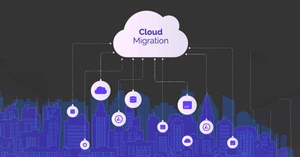What are Cloud Migration Tools?
Cloud migration entails transferring a company's digital operations from its legacy on-premises servers to servers hosted by a public cloud provider. This process may also involve transferring data and software among various cloud services. This transfer doesn't involve physically moving equipment but rather moving digital assets, services, databases, and IT resources into the cloud.
The motivation for cloud migration often arises from the need to leave behind outdated, inefficient legacy infrastructures or hardware that is no longer running optimally. Many organizations are opting for the cloud as it offers efficiency and performance. This might involve a partial or complete shift to the cloud.
Who Uses Cloud Migration Software?
Cloud migration software is a versatile tool that caters to the needs of multiple parties involved in the cloud migration process. Here's a breakdown of who uses cloud migration platforms;
- Migration Architects: A migration architect is the brain behind the cloud migration project. They are responsible for meticulously planning the migration and overseeing it to completion. The migration architect defines refactoring requirements, devises migration strategies, and sets priorities for a smooth transition.
- Database Architects: Database architects ensure that data migration to the cloud occurs seamlessly. They use cloud data migration software to identify the right databases for migration and ensure data integrity. Collaboration with cloud service providers like AWS and Azure is a key part of their role.
- IT Teams: IT teams are at the forefront of the migration project. They are hands-on with cloud migration software to guarantee that business requirements, budget constraints, service level agreements (SLAs), and key performance indicators (KPIs) are met. They also devise long-term IT strategies and operational plans.
- Cloud Service Providers: Cloud service providers themselves offer cloud migration options. They ensure the cloud infrastructure is reliable, scalable, consistent, and available as required. Prominent cloud platforms such as AWS, Microsoft Azure, Google Cloud, Alibaba Cloud, and IBM Cloud provide the ecosystem for migration.
- Business Owners: Business owners make migration decisions as an investment. They aim to secure a substantial long-term return on investment (ROI). They play a pivotal role in observing the total cost of ownership (TCO) and building a strong business case for migration.
Common Features of Cloud Migration Tools
Cloud migration tools come packed with various features to ease the shift to the cloud. Here, are the common features you can expect to find in these tools;
- Pre-migration Assessment: Cloud migration assessment tools should possess a pre-migration assessment feature. This function scrutinizes your applications and data, identifying any anomalies or potential issues before the migration begins.
- Performance Monitoring: Cloud migration tools often include application performance monitoring. This keeps an eye on how your applications are performing in public, private, and multi-cloud environments. It helps in optimizing their performance, ensuring they run smoothly.
- Data Replication: Data replication is a fundamental feature. It ensures that all your data from the previous cloud server or on-premises environment is securely copied to the new cloud setup. This guarantees that your data is consistently available for analysis and operations.
- Application Rehosting: Application rehosting enables the transfer of your existing on-site workload to alternative cloud servers with minimal alterations to the application. It's like picking up your application and shifting it to a new home.
- Application Replatforming: Using this capability, you can enhance your application to perform at its best on the cloud platform without affecting its essential functions. It adapts your app to the cloud environment, harnessing its full potential.
- Migration Process Tracking: This feature is all about keeping you informed and in control of the migration journey. It tracks the entire process, starting from the initial application assessment to the point where your workload is fully transferred to the new cloud environment.
Benefits of Using Cloud Migration Tools
Cloud migration offers a multitude of benefits, making the shift to the cloud not only smooth but also highly efficient. Let's explore the benefits of using these essential tools;
- Seamless Transition: Cloud migration tools facilitate the smooth transfer of data and workload when moving from on-premises to public, private, or hybrid cloud, or even between different cloud environments. The transition to cloud computing reduces infrastructure costs, and provides rapid deployment, automatic backup support, and scalability.
- Efficient Deployment: Cloud migration tools eliminate the need for on-premises infrastructure, and businesses by bypassing time-consuming tasks such as server procurement, operating system installations, and data center downtimes. This enables them to commence operations without the burden of additional tasks and expenses.
- Simplified Data Handling: Cloud migration software solutions have the capability to efficiently collect data from various sources within the enterprise and seamlessly transfer it to the selected cloud data center. This simplifies the overall migration procedure by removing the need for extra software.
- Data Protection: Cloud migration tools come with robust security features to safeguard data, processes, and applications during the migration process. This makes sure that sensitive information remains protected throughout the transition.
- Centralized Control: These tools act as a central point for stakeholders to initiate, execute, and monitor migration activities. The hub ensures compliance with migration procedures, providing a complete view of the entire process.
- Data-Driven Decisions: Cloud migration tools help provide insights and best practices for data deployment and organization by analyzing business data. They can assist organizations make data-driven and well-informed business decisions by helping them in planning, analyzing, and creating cloud cost models.
Top 10 Cloud Migration Tools
Here is a list of best cloud migration tools along with their features and prices;
| Software | Features | Price |
| Cisco AppDynamics | Application performance monitoring, Business performance monitoring, Infrastructure monitoring, Pre-migration assessment | INR 495.64/month/ CPU core |
| AvePoint Migration | Complete data analysis before migration, Real-time migration monitoring, Pre-scanning to detect anomalies, Data classification, Tenant-to-tenant migration | Price on Request |
| Azure Migrate | Cost optimization for efficient migration, Centralized dashboard to track migration process, Application modernization, Compliance management | Free to use for Azure customers |
| Carbonite Migrate Tool | AES 256-bit encryption data protection, Customized workflow automation, Data analyses before synchronization, Migration configuration and management | Price on Request |
| CloudM | Pre-migration assessment, Live Progress Reports, Document versioning, Document metadata restoring | Price on Request |
| Cloudsfer | Multi-User Migration, Cloud backup and migration scheduling, Multiple migration reports | Price on Request |
| Google Cloud Migration Tools | Data replication, Apps modernization, Google cloud console | Price on Request |
| Turbonomic | AI-based apps optimization, Automatic apps scaling, Propriety policy engine to boost compliance, Full-stack visualization into apps and infrastructure, IT resources management | INR 1,554.65/virtual server/ month |
| ScienceLogic PL 1 | Complete visibility into IT resources, Collect and visualize cloud data in one place, AI-based infrastructure and resource relationship management, Application and infrastructure dependencies tracking | INR 619.19/node/ month |
| Dynatrace | Root-cause application analysis, Real-time application assessment, Component-level resource consumption visibility, Anomalies detection pre and post cloud migration | INR 1,818.67/per month |
Factors to Consider When Buying Best Cloud Migration Tools
Several essential factors need to be carefully considered before choosing the right cloud migration software;
- Setting Clear Goals: This plan should outline your current position. Define what you aim to achieve with the migration, and establish key performance indicators (KPIs). These KPIs might differ from those used in your legacy infrastructure. The plan should consider various factors such as timelines, priorities, available resources, and funding.
- Prioritize Applications: Conduct a thorough assessment of all your applications, workloads, software, and services to determine which needs to be migrated. Not all applications may need to move, and some might perform better in a specific cloud environment. Ask questions like whether applications require redesign, the level of complexity involved, the best cloud environment for each application, and whether your chosen cloud service provider offers migration capabilities. This assessment helps identify what should or should not be migrated.
- Select the Cloud Service Provider: Consider whether the provider can support global-scale migration if needed in the future. Decide whether you'll opt for a single cloud provider or go for a multi-cloud or hybrid approach, depending on your business needs.
- Protecting Your Data: The transfer of data poses a potential security risk, and it's essential to manage this risk effectively. Implement robust security measures to prevent unauthorized access to your company's data.
- Putting the Plan into Action: With the groundwork laid, the migration process can commence. The complexity of the architecture, applications, data, and workloads will influence the migration timeline and approach.
Popular Cloud Migration Software Trends
Companies are making substantial investments in their cloud migration strategies to gain a competitive edge and achieve cost-efficiency. IT leaders are rapidly advancing their cloud adoption plans, not only to facilitate remote work but also to ensure the security and value of their data.
From migration to modernization
Companies are investing heavily in cloud migration to stay competitive and cut costs. IT leaders are fast-tracking cloud adoption for remote work and data security. A key trend is the shift from mere migration to comprehensive modernization. It's not only about transitioning to the cloud but also enhancing applications after the migration. The growing approach is end-to-end modernization, combining migration and updating legacy apps in the cloud. Vendors now seek partners capable of both migrating workloads and modernizing legacy applications, highlighting the importance of maximizing cloud potential.




















